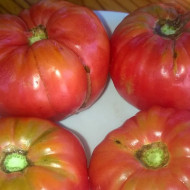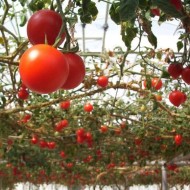How to grow a tomato tree at home and outdoors
Content
- 1 Description and features of the tomato tree
- 2 Tomato tree varieties with photos
- 3 The merits and demerits of culture
- 4 Required materials for growing
- 5 Video "Growing a tomato tree"
- 6 Features of germination of seedlings
- 7 Tomato tree care rules
- 8 Diseases and pests of the tomato tree
- 9 Harvesting and storage
- 10 Reviews of experienced gardeners
Description and features of the tomato tree
Disease resistant, high yielding, indeterminate plants with constant growth. The first months after planting, fruiting is not observed due to the active formation of the bush. Docking is prohibited, as it can injure the plant or provoke its death. Tomato trees with a periodicity of 3-4 leaves form clusters containing several fruits. In a mature state, the fruits turn red and reach a mass of 200-300 g. A thin skin covers the fleshy, dense pulp.
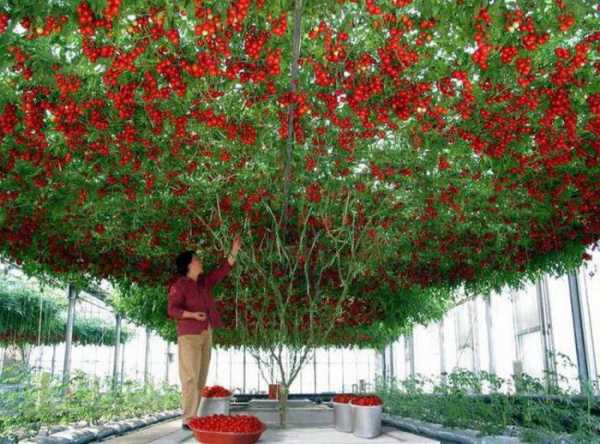
Tomato tree varieties with photos
The main varieties of the crop are:
- Miracle tree F1. Attracts gardeners with resistance to most known diseases. Under comfortable conditions, it reaches 2 meters and forms fruits weighing up to 280 g.
- Italian tree. Greenhouse view as it is sensitive to temperature. Requires the construction of supports, since it reaches 3 meters in height. Formation is carried out in 2 stems.
- Red Dragon. An early variety suitable for industrial and domestic cultivation. Under proper growing conditions, fruits can reach 300 g.
- Japanese tree or Octopus F1. The most popular variety due to its resistance to low temperatures, pleasant taste and long shelf life.
- Rotamer. The juiciness and sweetness of the fruit attracts lovers of salads and desserts.
- Rotamer
- Octopus F1
- Red Dragon
- Italian wood
- Miracle tree F1
The merits and demerits of culture
- immunity to sudden changes in air temperature;
- strong, branched root system;
- vigorous bushes, reaching 3-5 meters;
- resistance to most diseases;
- high productivity.
- demanding for large spaces is called the main disadvantage of this culture.
Most vegetable growers do not take up the cultivation of crops because of the cramped greenhouses.
Required materials for growing
Planning the cultivation of a tomato tree should address the following aspects:
- Planting material. Attention should be paid to tall species that are distinguished by an abundance of ovaries and good growth.
- Fertilizer, drugs against diseases and pests, compost. They can be purchased at specialized stores.
- Raw materials for the greenhouse. Heated greenhouses are relevant in Siberia and the Urals, and it is enough for the southern regions to shelter plantings at night.
- Barrel without base (metal).The culture requires a special planting site, which is filled with specialized substrates.
- Pump with hose (air). Regulates ventilation of the root system.
Video "Growing a tomato tree"
This video shows you how to plant tomato seedlings.
Features of germination of seedlings
The varieties are planted in a permanent place early enough. They begin to prepare seeds for germination in January-February.
Seed and soil preparation
Seeds bought in a specialized store are heated in an oven preheated to 50 ° C for 60-120 minutes. The procedure helps to increase the percentage of germination of the planting material. Immediately before planting, disinfection is carried out using "Fitosporin". In 300 g of liquid, 1-2 drops of the substance are diluted and the seeds are immersed. The duration of the procedure should not exceed 2 hours.
A tomato tree does not grow well in ordinary soil, therefore, a specialized soil mixture is prepared in advance. For its preparation, they take in equal proportions sod land, river sand and peat. The thoroughly mixed substrate is subjected to heat treatment, which kills all pathogenic microorganisms. For this, the mixture is kept in a preheated oven for no more than 30 minutes.
The disinfected substrate is enriched with nutrients. For this, carbamide (10 g) and superphosphate (30 g) are dissolved in 10 liters of water. The procedure will help the seeds germinate faster and form a healthy root system.
Planting seeds for seedlings
The best option for seedlings is considered to be wooden boxes, which are filled with a moistened mixture. Seeds are placed in the carved grooves and covered with soil on top. In this case, the distance between the rows should be at least 5 cm. The finished plantings are covered with glass and sent to a warm, well-lit place.
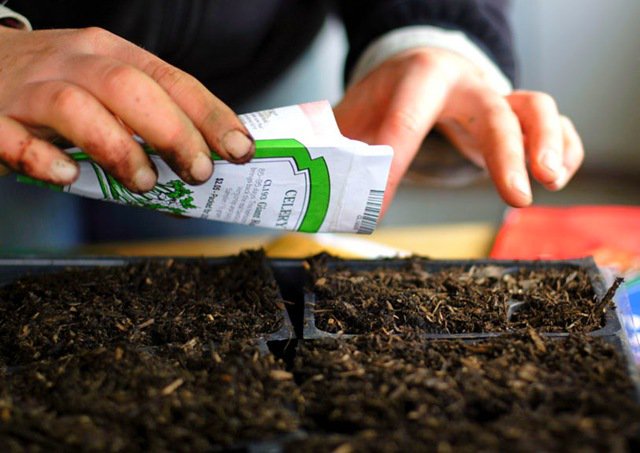
Growing seedlings requires constant moisture control, since seeds will not be accepted in dry soil. It must be moistened regularly and carefully so as not to wash the planting material. Spraying from a spray bottle is the best option.
Selecting and preparing a place for transplant
An indispensable condition for growing a tomato tree is the right place. One plant forms shoots that are many meters long, which need a lot of space. The area for placing barrels should be well lit, since the culture needs a lot of sunlight. Installed drums are filled with urgas (bottom layer) and EM compost (top layer).
Transplanting seedlings into open ground
Not all seedlings take root in the open field. Therefore, the most developed plants are allowed to be transplanted. In the filled containers, holes are made, which should not be larger than the volume of the previous pots. Seedlings are planted in them, and a support is mounted next to them so that the bushes do not break from the weight of the fruit.

Features of planting at home
The main requirement for high-quality planting of seedlings at home is the weather and temperature. It is forbidden to start the procedure if the mark on the thermometer does not exceed 10 ° C. In harsh climatic conditions, the arrangement of greenhouses will be required.
The specifics of growing in a greenhouse
When transplanting seedlings, they focus on the microclimate inside the greenhouse. It is equipped with a good ventilation system to prevent high humidity. The temperature should not be lower than 5-10 ° C.
Tomato tree care rules
It is possible to grow a tomato tree, provided that all agrotechnical requirements are met. When planting a variety of nightshades for the first time, you need to familiarize yourself with specialized literature and pay attention to the recommendations of experienced gardeners.
Watering and soil care
Although common tomato varieties do not tolerate waterlogging well, the tomato tree requires frequent watering.It is recommended to add water at least 4 times a week. The amount of liquid per plant should be 8-10 liters. In hot summer conditions, daily soil moisture is allowed.
Loosening the potting soil will help prevent many diseases, as well as reduce moisture levels. The procedure is designed to provide free air circulation in the plant root system.

Fertilization
The plant needs systematic feeding from the first days of summer. By this time, it absorbs all the nutrients stored in the soil. It is recommended to apply mullein, superphosphate and ammonium nitrate every 2-3 weeks until the end of the fruiting period. Sometimes boron is added, the lack of which is noticed by the depletion of the stems and brown spots on the fruits.
Stealing and processing
The first procedure is carried out no earlier than 7-8 days after planting the seedlings in barrels. At this stage, only the lower shoots are allowed to be removed. Then the bare trunk is covered with a mixture (urgas and earth). This will help nourish and strengthen the tree's root system. The repeated procedure is carried out one week after the first one.
Slow fruiting is a common problem with this species of nightshade. Therefore, the trees are periodically treated with a special solution prepared from natural ingredients:
- Shredded pine shoots are kept in the freezer for a couple of weeks.
- After that, they are placed in water, boiled for 30 minutes and filtered.
- The resulting broth is diluted with cold water in a ratio of 1: 3. It is necessary to resort to processing at the stage of bud formation.
Diseases and pests of the tomato tree
The tomato tree is susceptible to various diseases and pest attacks. Their root cause is not only a specific feature, but also improper care. Preventive treatments with iodine solution (1 bottle per 10 liters of water) are very effective. However, under certain circumstances, preventive measures will not be enough.
The plant's susceptibility to late blight is small, but several times during the planting season they are sprayed with the preparation "Fitosporin" (1 tablespoon per bucket of water). It also helps to cope with gray rot and septoria. A well-established air circulation will help to reduce the percentage of infection by fungal diseases - it will reduce the level of humidity and prevent the development of harmful bacteria.
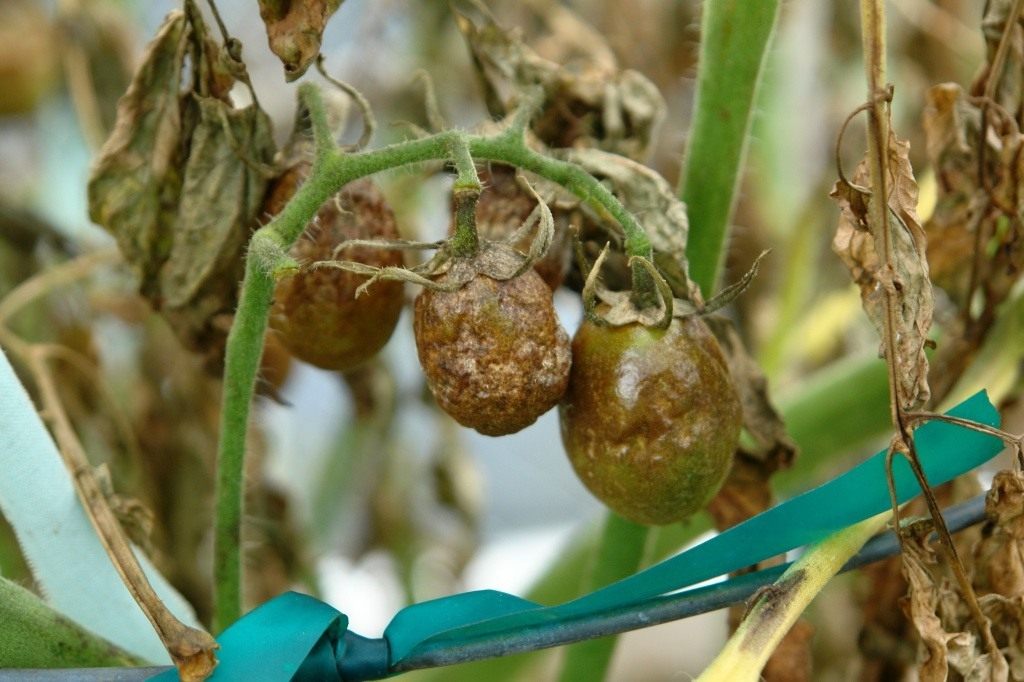
Disease is not the only threat to tomato trees. Many gardeners are faced with harmful insects, for example, bear or wireworm. They attack the very heart of the plant, namely the root system. Experienced gardeners recommend planting garlic and marigolds around the perimeter. They will be able to scare off pests without the use of pesticides.
Harvesting and storage
The beginning of the fruiting period directly depends on the specific variety of cyfomandra (tomato tree). Harvesting of fruits begins after they are fully ripe. In this case, fruiting is delayed until late autumn. It is recommended to store the crop in a cellar or specially prepared rooms with a temperature maintained in the range of 10-15 ° C.
It is prohibited to use frozen fruits.
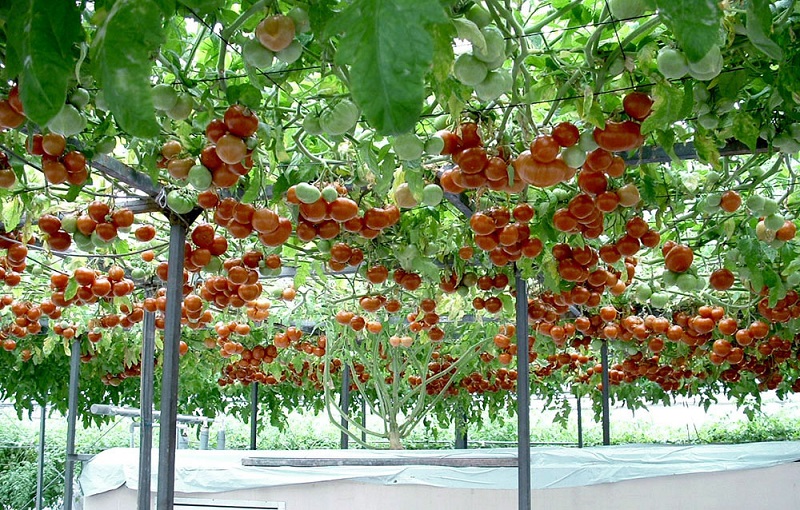
Reviews of experienced gardeners
“For many years I have been giving preference to familiar tomato varieties. However, he still decided to grow a tree in a barrel with his own hands. The result exceeded all expectations - I have never harvested so many tomatoes. "
“Having once grown an Italian tree on my site, I realized that this is the best variety of tomatoes. The plant requires an investment of effort and money, but it brings excellent results. During the season I have harvested about 10 kg from one tree. "
Gardeners are wary of growing a tomato tree on their site due to the peculiarities of its agricultural technology. However, the effort spent will turn into a rich harvest, which will bring each plant planted.




